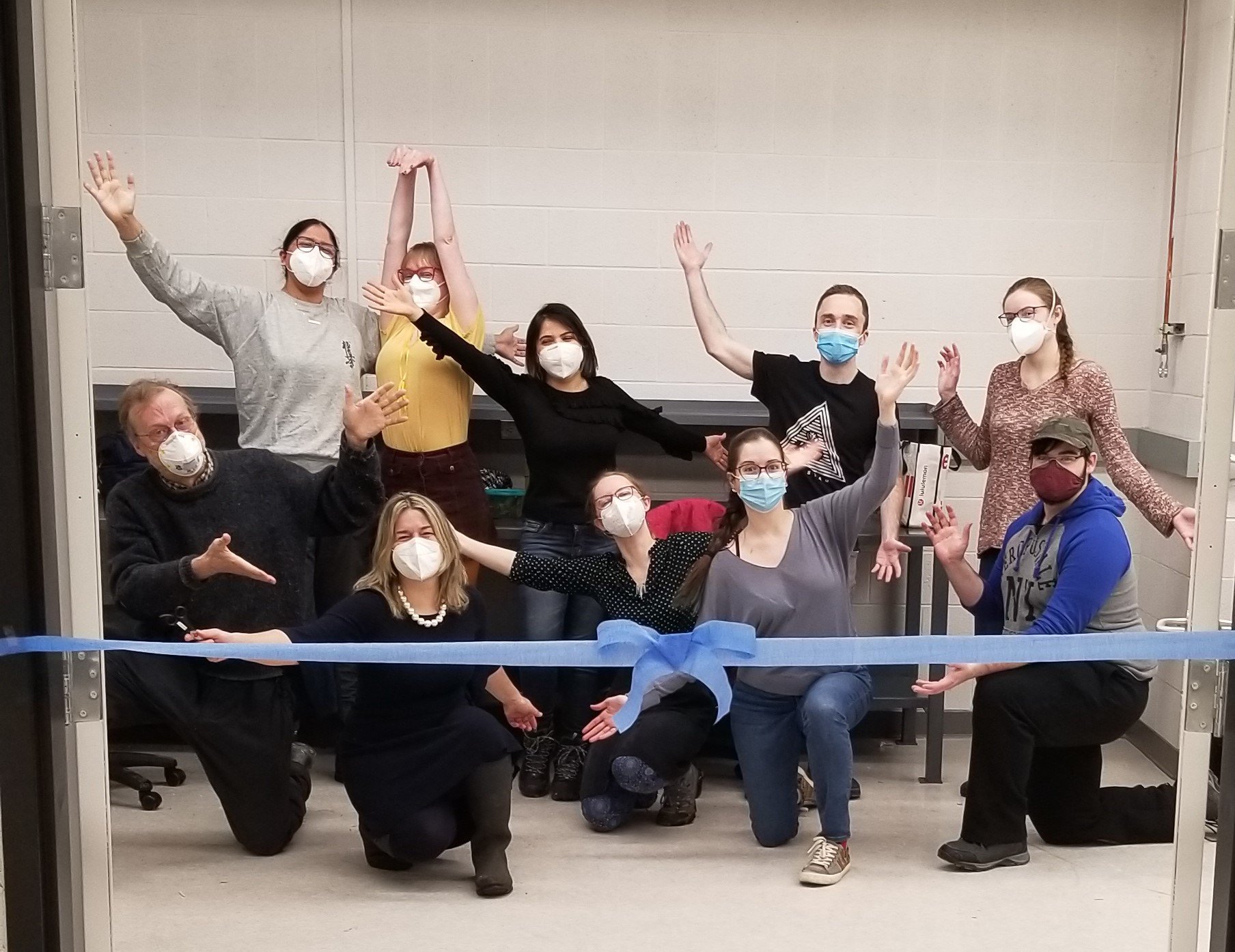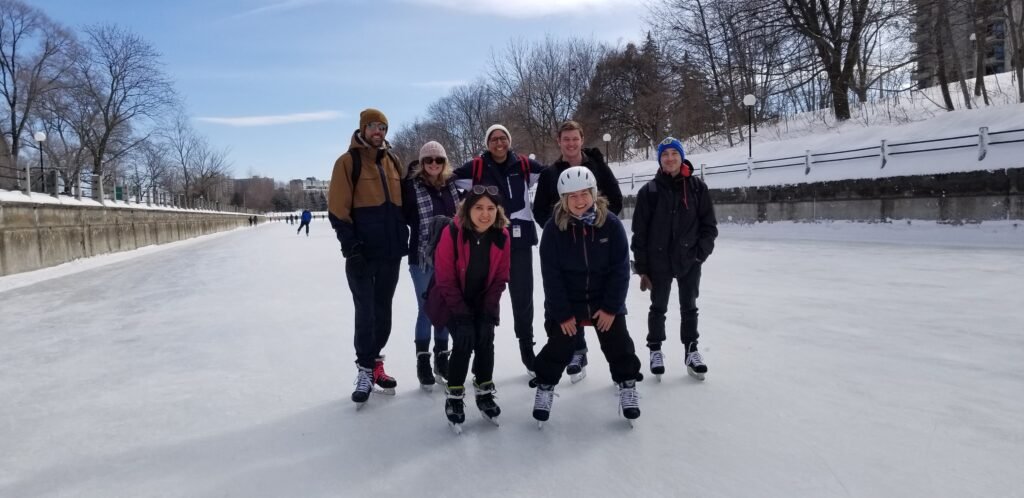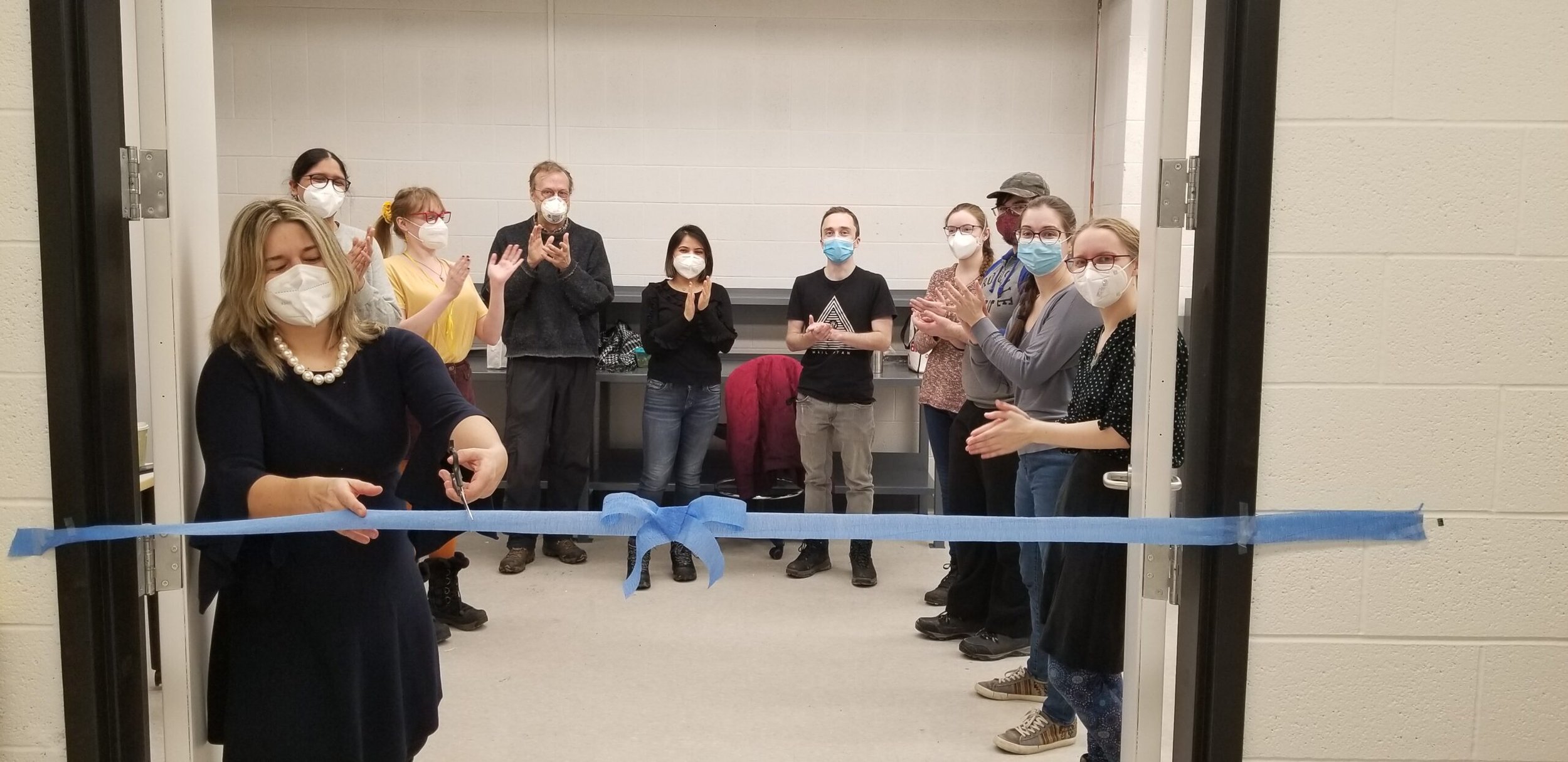
SUNLAB News
SUNLAB students awarded scholarships
Congratulations to SUNLAB students Nick Anderson, Nicholas Dallaire and Victoria Jancowski on receiving prestigious scholarships to support their research.
MASc electrical engineering candidate Nick Anderson has been awarded a Canada Graduate Scholarship – Master’s program. This scholarship is meant to develop trainee research skills by “supporting students who demonstrate a high standard of achievement in undergraduate and early graduate studies."
MSc physics candidate Nicholas Dallaire has been awarded an Ontario Graduate Scholarship. This merit-based scholarship is available to graduate students in all disciplines of academic study. The Ontario Graduate Scholarships program is jointly funded by the Province of Ontario and Ontario universities.
BASc electrical engineering candidate Victoria Jancowski is spending the summer at the SUNLAB performing research on spectroradiometric standards for bifacial photovoltaic solar power. She has been awarded a CSA Group Undergraduate Research Scholarship, which aims to support undergraduate students in the pursuit of novel research related to standards, and a Faculty of Engineering Women Undergraduate Summer Student Research Award, which is intended to encourage students to pursue graduate studies in engineering or computer science.
References
Natural Sciences and Engineering Research Council of Canada (retrieved June 29, 2022). Canada Graduate Scholarships - Master's program. https://www.nserc-crsng.gc.ca/Students-Etudiants/PG-CS/index_eng.asp
Ontario Student Assistance Program (retrieved June 16, 2022). Ontario Graduate Scholarship (OGS) Program: https://osap.gov.on.ca/OSAPPortal/en/A-ZListofAid/PRDR019245.html
CSA Group (retrieved June 16, 2022). CSA Group Undergraduate Research Scholarship: https://www.csagroup.org/csa-group-undergraduate-research-scholarship/
SUNLAB winter thesis defences
Congratulations to Laurier Baribeau, Robert Pollak and Mikhak Samadi who defended their theses earlier this year! They received their diplomas this week at the spring convocation. You can now find their theses on ruor.uottawa.ca:
Laurier Baribeau, MASc Electrical Engineering, Design of multi-junction solar cells incorporating silicon-germanium-tin alloys with finite-element analysis and drift-diffusion model, DOI: 10.20381/ruor-27436
Robert Pollak, MASc Electrical Engineering, Realizing the energy transition with distributed photovoltaics: A study of high PV penetration grid-edge network dynamics, DOI: 10.20381/ruor-27713
Mikhak Samadi, PhD Electrical Engineering, Data-driven demand management for smart grid, DOI: 10.20381/ruor-27782
New Publications from the SUNLAB: Photonics West Conference Proceedings
Congratulations to MASc candidates Nick Anderson, Trevor Coathup and Ras-Jeevan Obhi for the publication of proceedings following their presentations at SPIE Photonics West. You can download their papers and view their presentations using the links below.
T. J. Coathup, M. R. Lewis, A. C. J. Russell, A. Conesa, J. Guerrero-Perez, C. E. Valdivia, and K. Hinzer, Impact of reflective torque tube on rear side irradiance in bifacial photovoltaic modules, SPIE Photonics West 2022, San Francisco, CA, January 22-27, 2022. DOI: 10.1117/12.2615658, hdl.handle.net/10393/43517
N. Anderson, V. Tatsiankou, K. Hinzer, R. Beal, and H. Schriemer, Probabilistic description of short-term cloud dynamics from rapid sampling of the solar spectral irradiance, SPIE Photonics West 2022, San Francisco, CA, January 22-27, 2022. DOI: 10.1117/12.2616231, hdl.handle.net/10393/43519
R.-J. K. Obhi, S. W. Schaefer, C. E. Valdivia, P. J. Poole, J. Liu, Z. Lu, and K. Hinzer, Height distributions of uncapped InAs/InGaAsP/InP quantum dashes and their effect on emission wavelengths, SPIE Photonics West 2022, San Francisco, CA, January 22-27, 2022. DOI: 10.1117/12.2609954, hdl.handle.net/10393/43518
Ribbon cutting ceremony for SUNLAB new laboratories
Earlier this month, the SUNLAB inaugurated its new laboratories in Colonel By Hall. This new space will be used for research on next generation photovoltaics for smart grid systems. Many SUNLAB students and researchers were on hand to watch SUNLAB director Karin Hinzer cut the ribbon.

Back row: Ras-Jeevan Obhi, Erin Tonita, Neda Nouri, Mathieu de Lafontaine and Meghan Beattie.
SUNLAB Skating!
SUNLAB members enjoyed the world's largest skating rink on a regular basis this winter.

Back row: Gavin Forcade, Erin Tonita, Ras-Jeevan Obhi, Nick Anderson and Mathieu de Lafontaine.
New Publication from the SUNLAB: Solar Energy Materials and Solar Cells

A recent study led by SUNLAB PhD candidate Erin Tonita in collaboration with Arizona State University’s DEfECT Lab has been published in Solar Energy Materials and Solar Cells. The authors investigated the effect of incident spectra on current loss in high efficiency textured bifacial silicon heterojunction solar cells. They developed an optoelectronic model capable of simulating the response of these cells to a variety of spectral conditions, and validated the model with fabricated cells. They calculated a decrease in parasitic absorption of up to 50% rel. with air mass (AM) increasing from 1.5 to 10 and a slight rise (~0.5% abs.) in c-Si recombination. The combined effect resulted in overall improved cell efficiency up to AM5 for front illumination and rear illumination with unity albedo. When the spectral albedo of dry-grass was considered on the rear face, this resulted in a sharp decrease in efficiency with increased AM, unlike the case of unity albedo.
Overall, current-collection and efficiency trends emphasized the importance of considering spectral effects in energy yield models. As efficiency tends to rise with AM, this will enhance energy yield in mid-to-high latitude locations, which have significant power contributions at high AM.
Rear the full article here in Solar Energy Materials and Solar Cells.
E. M.Tonita, C. E. Valdivia, M. Martinez-Szewczyk, M. R. Lewis, M. I. Bertoni, and K. Hinzer, Effect of air mass on carrier losses in bifacial silicon heterojunction solar cells, Sol. Energy Mater. Sol. Cells. 230(111293) (2021). DOI: 10.1016/j.solmat.2021.111293
New Publication from the SUNLAB: Progress in Photovoltaics
SUNLAB researchers, including lead author PhD candidate Gavin Forcade, in collaboration with researchers at the Université de Sherbrooke, the French Commissariat à l’énergie atomique et aux énergies alternatives (CEA) and in part supported by collaborators from STACE, recently published new results in Progress in Photovoltaics. They investigated an antireflection coating consisting of a monolayer of close-packed silica microbeads partially submerged within a polydimethylsiloxane (PDMS) encapsulant, for concentrator photovoltaic (CPV) submodules. Comparing to a commercialized SiOx encapsulant for a reference 500x CPV submodule, they measured a 2.6% higher short-circuit current. In addition, they performed a series of simulations and predicted further improvements up to 3.4% for smaller beads with a deeper submergence.
This work demonstrates the ability of the microbeads/PDMS encapsulant to improve the performance of present CPV modules, thereby promoting further study to incorporate the encapsulant commercially.
Find out more details in this article in Progress in Photovoltaics.
G. P. Forcade, A. Ritou, P. St-Pierre, O. Dellea, M. Volatier, A. Jaouad, C. E. Valdivia, K. Hinzer, and M. Darnon, Microstructured antireflective encapsulant on concentrator solar cells, Prog. Photovoltaics: Res. Appl. (2021). DOI: 10.1002/pip.3468
SUNLAB summer thesis defences
Congratulations to Meghan Beattie and Kayden Kaller who recently defended their theses! They will receive their diplomas at the fall convocation. You can now find their theses on ruor.uottawa.ca:
Meghan Beattie, PhD Physics, Semiconductor materials and devices for high efficiency broadband and monochromatic photovoltaic energy conversion, DOI: 10.20381/ruor-26695
Kayden Kaller, MASc Electrical Engineering, Aspects of photovoltaic systems: Study and simulation of silicon phthalocyanine bulk heterojunction solar cells and monochromatic photonic power converters, DOI: 10.20381/ruor-26846
SUNLAB director Karin Hinzer returns to CBC Radio's All in a Day
After a first appearance on CBC Radio's All in a Day last November, SUNLAB director Karin Hinzer was reinvited to its segment "Element of Surprise" where she discussed the use of indium in her research. Click here for the full interview which had its first broadcast on July 27.
uOttawa Innovates - Frontiers in Photovoltaics
Join Professor Karin Hinzer and her team from uOttawa’s SUNLAB with special guest former SUNLAB postdoctoral fellow Dr. Richard Beal from Spectrafy. The team will highlight their research in photovoltaic technologies and systems that generate energy from light, from cutting-edge photonic power transmission technology to photovoltaic system design in Canada’s High Arctic to state-of-the-art measurements of the solar resource.
Register using Eventbrite:
ENGLISH: https://www.eventbrite.ca/e/159640437847
FRENCH: https://www.eventbrite.ca/e/159662868939
Contacts: Chantal St-Amour, Kyle Bournes
Date: Tuesday, June 22, 2021
Time: 3 p.m.
SUNLAB students awarded scholarships
Congratulations to SUNLAB students Gavin Forcade, Mandy Lewis, Ras-Jeevan Obhi and Annie Russell on receiving prestigious scholarships from the Natural Sciences and Engineering Research Council of Canada.
Both Gavin Forcade and Mandy Lewis have been awarded an Alexander Graham Bell Canada Graduate Scholarship. This scholarship rewards top-level graduate students at Canadian institutions with the goal of enabling "a high-quality research training experience for award holders" and fostering "impacts within and beyond the research environment." Gavin is a PhD physics candidate and Mandy is a PhD electrical engineering candidate.
PhD electrical engineering candidate Annie Russell has been awarded a Postgraduate scholarship - Doctoral program. This support will allow her to "fully concentrate on their studies and to seek out the best research mentors in their chosen fields".
Ras-Jeevan Obhi has been awarded a Canada Graduate Scholarship - Master's program. This scholarship is meant to develop trainee research skills by "supporting students who demonstrate a high standard of achievement in undergraduate and early graduate studies." Ras-Jeevan is an MASc electrical engineering candidate.
Reference
Natural Sciences and Engineering Research Council of Canada (retrieved May 4, 2021). Postgraduate Programs. https://www.nserc-crsng.gc.ca/Students-Etudiants/PG-CS/index_eng.asp
SUNLAB director awarded new Canada Foundation for Innovation funding
Congratulations to SUNLAB director Dr. Karin Hinzer and Centre for Research in Photonics at the University of Ottawa director Dr. Pierre Berini on being awarded new funding from the Canada Foundation for Innovation (CFI) for their project titled "Transformative nanophotonics". This project is one in 23 across Canada to receive an "exceptional project" designation from the CFI. It will increase the miniaturization and integration of advanced photonic materials and improve fabrication processes in various industries, including telecommunications, health care, manufacturing, and energy.
Read more about "Transformative nanophotonics" and other University of Ottawa projects which have been awarded new funding from the CFI.
SUNLAB student wins Paper Award at OWPT2021
Congratulations to PhD candidate Meghan Beattie and her research collaborators from the SUNLAB and the Fraunhofer Institute for Solar Energy Systems on winning a Paper Award at the 3rd Optical Wireless and Fiber Power Transmission Conference (OWPT) this week. Meghan presented a talk titled "Non-uniform illumination impacts on O-band InGaAsP and metamorphic GaInAs photonic power converters" at this online conference hosted in Japan.
New Publication from the SUNLAB: Applied Physics Letters
SUNLAB researchers, including lead author PhD candidate Meghan Beattie, in collaboration with researchers at the University of Waterloo, recently published new results in Applied Physics Letters. They investigated the effect of growth temperature during molecular beam epitaxy on the performance of an InAlGaAs tunnel diode grown on InP and fully transparent at wavelengths above 1000 nm. They demonstrated a 10- to 100-fold improvement in peak current resulting from a 20°C reduction in growth temperature, achieving current densities exceeding 1200 A/cm2. This is an order of magnitude higher than what has previously been demonstrated in similar devices. The authors also presented a dual-junction photonic power converter designed for operation in the telecommunications O-band, showing that the tunnel diode can survive the growth of subsequent junctions.
This work represents an important step forward in the development of InP-based multi-junction photovoltaics for very high illumination intensities in the near-infrared and highlights the importance of minimizing unwanted dopant segregation, illustrating a path toward significant performance improvements through optimization of the growth temperature.
Find out more details in this article in Applied Physics Letters.
M. N. Beattie, C. E. Valdivia, M. M. Wilkins, M. Zamiri, K. L. C. Kaller, M. C. Tam, H. S. Kim, J. J. Krich, Z. R. Wasilewski, and K. Hinzer, High current density tunnel diodes for multi-junction photovoltaic devices on InP substrates, Appl. Phys. Lett. 118(062101) (2021). DOI: 10.1063/5.0036053
SUNLAB awarded funding for a collaborative project with the National Research Council
Congratulations to SUNLAB director Dr. Karin Hinzer (principal investigator) and Dr. Trevor Hall (co-principal investigator) on being awarded $299,970 in funding to collaborate with the National Research Council on a project as part of the High-throughput and Secure Networks Challenge Program.
Their research project on terabit optical networks based on quantum dot lasers and photonic integration (TERAQD) will expand the laser bandwidth of the National Research Council's mode-locked InP based quantum dot lasers, enabling a larger number of optical data channels to be multiplexed. TERAQD will also leverage the unique properties of quantum dots to enable stable and efficient operation over a range of 0 to 100°C.
These innovations have the potential to dramatically improve transmission of data and communications with remote regions across Canada while reducing greenhouse gas emissions from data traffic.
SUNLAB summer thesis defences
Many SUNLAB students were busy writing their theses this spring and defending them this summer. Congratulations to Rachel Belcher, Warren Gies, Mandy Lewis, Kevin Shimotakahara and Viktar Tatsiankou! These students will receive their diplomas at the fall convocation. You can now find their theses on ruor.uottawa.ca:
Rachel Belcher, Fuzzy logic based module-level power electronics for mitigation of rapid cloud shading in photovoltaic systems, MASc Electrical Engineering thesis, DOI: 10.20381/ruor-25425
Warren Gies, Conditions for maximum operating efficiency of a multi-junction solar cell and a proton exchange membrane electrolyser system for hydrogen production, MSc Physics thesis, DOI: 10.20381/ruor-25209
Mandy Lewis, Performance of silicon heterojunction cells and modules in Arctic applications: Impact of angle of incidence, air mass, and spectra on energy yield, MASc Electrical Engineering thesis, DOI: 10.20381/ruor-25388
Viktar Tatsiankou, Design principles and field performance of software-augmented solar sensors for resolving spectral irradiance and atmospheric parameters, PhD Electrical Engineering thesis, DOI: 10.20381/ruor-25005
Kevin Shimotakahara, Device to device communications for smart grid, MASc Electrical Engineering thesis, DOI: 10.20381/ruor-24884
New Publication from the SUNLAB: IEEE Journal of Photovoltaics
Earlier this summer, SUNLAB senior research scientist Dr. Chris Valdivia and SUNLAB director Dr. Karin Hinzer published new designs for multijunction solar cells by using subcell segmentation.
Subcell segmentation is a method to obtain nearly ideal current-matching while employing nonideal bandgap combinations in high-efficiency multijunction solar cells. By splitting each subcell into multiple semitransparent pn junctions, called segments, current-matching can be satisfied by layer design rather than material selection. This architecture replaces the standard requirement for an optimal combination of bandgaps with a simpler requirement for optimal layer thicknesses in each series-connected segment.
Find more details in this article in the IEEE Journal of Photovoltaics.
C. E. Valdivia and K. Hinzer, Subcell segmentation for current matching and design flexibility in multijunction solar cells, IEEE Journal of Photovoltaics (2020). DOI: 10.1109/JPHOTOV.2020.3005630.
New Publication from the SUNLAB: Communications Materials
Former SUNLAB PhD student Dr. Ross Cheriton and collaborators from McGill University, the Institut national de la recherche scientifique and the University of Michigan have demonstrated sequential two-photon current generation with sub-bandgap photons, the hallmark of intermediate band solar cell operation, through vertically stacked quantum dots in nanowires. Find more details in this article in Communications Materials.
R. Cheriton, S. M. Sadaf, L. Robichaud, J. J. Krich, Z. Mi, and K. Hinzer, Two-photon photocurrent in InGaN/GaN nanowire intermediate band solar cells, Comms. Mater. 1(63) (2020). DOI: 10.1038/s43246-020-00054-6
SUNLAB Director Karin Hinzer Nominated Vice-Dean, Research

Congratulations to SUNLAB Director Karin Hinzer, who has been nominated Vice-Dean, Research at the Faculty of Engineering. Her appointment began on July 1, 2020 and will continue for 5 years. Professor Hinzer is the University Research Chair in Photonic Devices for Energy and a Professor at the School of Electrical Engineering and Computer Science at the University of Ottawa with a cross-appointment in the Department of Physics.
As expressed by the Dean of the Faculty of Engineering, Jacques Beauvais, “I’m extremely grateful to Karin for accepting this mandate at a time of great challenge and of tremendous opportunities and I’m also very pleased that the Faculty will benefit significantly from her great qualities that she has shared with us in both her research and management activities since her arrival in the Faculty in 2007”.
Congratulations Professor Hinzer, from all of us at the SUNLAB!



